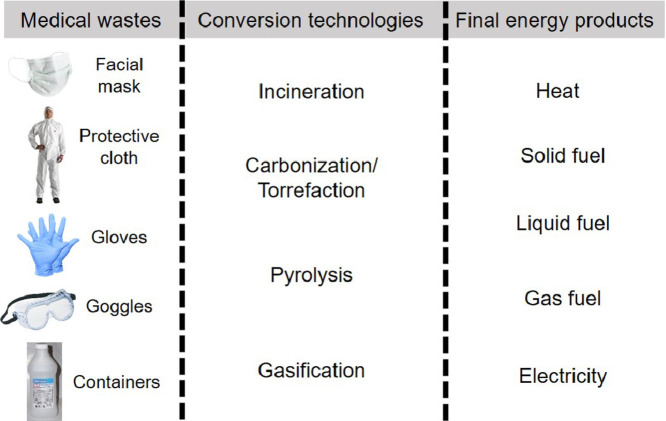- Record: found
- Abstract: found
- Article: not found
Technological review on thermochemical conversion of COVID-19-related medical wastes

Read this article at
Highlights
-
•
COVID-19 pandemic brought huge amount of medical wastes, which is mainly made of plastic polymer.
-
•
Thermochemical treatments (incineration, torrefaction, pyrolysis, and gasification) are reviewed.
-
•
The review focuses on the applicability of those technologies to convert the medical wastes.
-
•
Incineration has the highest material flexibility, followed by gasification and pyrolysis.
-
•
Gasification and pyrolysis are considered as the most promising conversion technologies.
Abstract
COVID-19 pandemic has brought tremendous environmental burden due to huge amount of medical wastes (about 54,000 t/d as of November 22, 2020), including face mask, gloves, clothes, goggles, and sanitizer/disinfectant containers. A proper waste management is urgently required to mitigate the spread of the disease, minimize the environmental impacts, and take their potential advantages for further utilization. This work provides a prospective review on the possible thermochemical treatments for those COVID-19 related medical wastes (CMW), as well as their possible conversion to fuels. The characteristics of each waste are initially analyzed and described, especially their potential as energy source. It is clear that most of CMWs are dominated by plastic polymers. Thermochemical processes, including incineration, torrefaction, pyrolysis, and gasification, are reviewed in terms of applicability for CMW. In addition, the mechanical treatment of CMW into sanitized refuse-derived fuel (SRDF) is also discussed as the preliminary stage before thermochemical conversion. In terms of material flexibility, incineration is practically applicable for all types of CMW, although it has the highest potential to emit the largest amount of CO 2 and other harmful gasses. Furthermore, gasification and pyrolysis are considered promising in terms of energy conversion efficiency and environmental impacts. On the other hand, carbonization faces several technical problems following thermal degradation due to insufficient operating temperature.
Graphical abstract
Related collections
Most cited references134
- Record: found
- Abstract: found
- Article: not found
Persistence of coronaviruses on inanimate surfaces and their inactivation with biocidal agents
- Record: found
- Abstract: found
- Article: not found
Stability of SARS-CoV-2 in different environmental conditions
- Record: found
- Abstract: not found
- Article: not found

